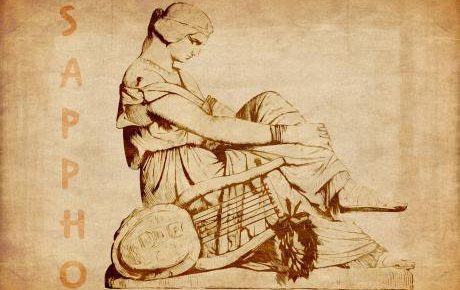Primary Sources:
- Mason, Chris. “Bright Lyre Becomes Voice: Translating Sappho into Songs.” The Antioch Review 67, no. 1 (2009): 108-12. Accessed February 22, 2020. www.jstor.org/stable/25475695
- Roberts, Helen. “Reconstructing the Greek Tortoise-Shell Lyre.” World Archaeology 12, no. 3 (1981): 303-12. http://www.jstor.org/stable/124242.
- Sappho. Sappho: A New Translation of the Complete Works. Translated by Diane J. Rayor, and André Lardinois. New York: Cambridge University Press, 2014.
- Sappho. If Not Winter: Fragments of Sappho. Translated by Anne Carson. New York: Alfred A Knopf, 2002.
Secondary Sources:
- Anderson, Warren D. Music and Musicians in Ancient Greece. Ithaca: Cornell University Press, 1994.
- Agnew, Vanessa. “Reenacting the Stone Age: Journeying Back in Time Through the Uckermark and Western Pomerania,” in A Companion to Public History, edited by David Dean, 365-374. John Wiley & Sons Ltd, 2018. DOI:10.1002/9781118508930
- Bowie, Ewen. “How Did Sappho’s Songs Get Into the Male Sympotic Repertoire?” In The Newest Sappho, P.Sapph Obbink and P.GC inv. 105, frs 1-4 : Studies in Archaic and Classical Greek Song, Vol. 2, edited by Anton Bierl, and André Lardinois, 148-166. Boston: Brill, 2016
- Campbell, David A. Greek Lyric Poetry. Great Britain: Bristol, Bristol Classical Press, 1982.
- Clay, Diskin. “The Theory of the Literary Persona in Antiquity.” Materiali E Discussioni per L’analisi Dei Testi Classici, no. 40 (1998): 9-40. doi:10.2307/40236116.
- Constantakopoulou, Christy. The Dance of the Islands: Insularity, Networks, the Athenian Empire, and the Aegean World, Oxford University Press, Incorporated, 2007. ProQuest Ebook Central.
- Daitz, Stephen G. “Further Notes on the Pronunciation of Ancient Greek.” The Classical World 95, no. 4 (2002): 411. https://doi.org/10.2307/4352678.
- Dean, David. Introduction to A Companion to Public History, 1-13. Edited by David Dean. John Wiley & Sons Ltd, 2018. DOI:10.1002/9781118508930
- Dillon, Matthew. “The Erasmian Pronunciation of Ancient Greek: A New Perspective.” The Classical World 94, no. 4 (2001): 323. https://doi.org/10.2307/4352587.
- Ellis-Evans, Aneurin. The Kingdom of Priam: Lesbos and the Troad between Anatolia and the Aegean. Oxford: Oxford University Press, 2019. Oxford Scholarship Online, 2019. doi: 10.1093/oso/9780198831983.001.0001.
- Gombosi, Otto. “New Light on Ancient Greek Music.” Papers Read by Members of the American Musicological Society at the Annual Meeting, 1939, 1939, 168–83.
- Gosetti-Murrayjohn, A. “Sappho’s Kisses: Biographical Tradition and Intertextuality in “AP” 5.246 and 5.236.” The Classical Journal102, no. 1 (2006): 41-59. www.jstor.org/stable/30038674.
- Hallett, Judith P. “Sappho and Her Social Context: Sense and Sensuality.” Signs 4, no. 3 (1979): 447-64. www.jstor.org/stable/3173393.
- Halporn, W. James, Martin Ostwold, and Thomas G. Rosenmeyer. The Meters of Greek and Latin Poetry. Norman: University of Oklahoma Press, 1963.
- Lardinois, André. “Who Sang Sappho’s Songs?” In Reading Sappho: Contemporary Approaches, Classics and Contemporary Thought Volume 2,edited by Ellen Greene, 150-172. Berkley, University of California Press, 1996.
- Maas, Martha. “Polychordia and the Fourth-Century Greek Lyre,” n.d., 16.
- Maas, Martha, and Jane McIntosh Snyder. Stringed Instruments of Ancient Greece. Massachusetts, West Hanover: Yale University Press, 1989.
- Mulroy, David. Early Greek Lyric. Ann Arbor: University of Michigan Press, 1992.
- Obbink, Dirk. “The Newest Sappho: Text, Apparatus Criticus, and Translation.” In The Newest Sappho, P.Sapph Obbink and P.GC inv. 105, frs 1-4 : Studies in Archaic and Classical Greek Song, Vol. 2, edited by Anton Bierl, and André Lardinois, 1-13. Boston: Brill, 2016
- Penrose Walter “Sappho’s Shifting Fortunes from Antiquity to the Early Renaissance,” Journal of Lesbian Studies 18, no. 4 (October 2014): 415-36 http://search.ebscohost.com/login.aspx?direct=true&db=qth&AN=98838222&site=ehost-live
- Politis, Dionysios, Dimitrios Margounakis, Spyridon Lazaropoulos, Leontios Papaleontiou, George Botsaris, and Konstantinos Vandikas. “Emulation of Ancient Greek Music Using Sound Synthesis and Historical Notation.” Computer Music Journal 32, no. 4 (2008): 48–63.
- Pomeroy, Sarah B. Goddesses, Whores, Wives, and Slaves: Women in Classical Antiquity. New York: Schocken Books, 1995.
- Powell, Jim. The Poetry of Sappho. New York: Oxford University Press, Incorporated, 2007. ProQuest Ebook Central.
- Rayor, Diane. “Reimagining the Fragments of Sappho through Translation.” In The Newest Sappho: P. Sapph. Obbink and P. GC Inv. 105, Frs. 1-4: Studies in Archaic and Classical Greek Song, Vol. 2, edited by Bierl Anton and Lardinois André, 396-412. LEIDEN; BOSTON: Brill, 2016.
- Roberts, Helen. “The Technique of Playing Ancient Greek Instruments of the Lyre Type.” In The British Museum Yearbook 4: Music and Civilization, edited by T.C. Mitchell, 43-76. Great Britain: London, British Museum Publications, 1980.
- Robinson, David M. (David Moore), 1880-1958. Sappho And Her Influence. New York: Cooper Square Publishers, 1963.
- Stehle, Eva. Performance and Gender in Ancient Greece: Nondramatic Poetry in Its Setting. Princeton University Press, 1997. www.jstor.org/stable/j.ctt7zvggb.
- Snyder, Jane McIntosh. “The Barbitos in the Classical Period.” The Classical Journal 67, no. 4 (1972): 331–40.
- Tyson, A.M. “Reenacting and Reimagining the Past” In A Companion to Public History, edited by David Dean 351-364. John Wiley & Sons Ltd, 2018. DOI:10.1002/9781118508930
- Winnington-Ingram, R.P. “The Pentatonic Tuning of the Greek Lyre: A Theory Examined.” The Classical Quarterly 6, no. no 3/4 (1956): 169–86.
